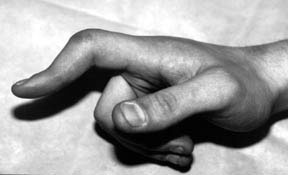
General Information
If you jam your finger while playing volleyball or basketball, you might notice that it takes on an odd appearance. The middle joint bends down and the fingertip end joint bends back. This is the characteristic shape of a boutonnière deformity, an injury to the tendons that straighten the fingers. About one-third of all people with rheumatoid arthritis also have fingers with boutonnière deformities.

 Several tendons work together to straighten the finger. The tendons run along the side and top of the finger. The tendon on the top attaches to the middle bone of the finger (the central slip of tendon). A forceful blow to the bent finger or a cut on the top of the finger can sever the central slip from its attachment to the bone. The tear looks like a buttonhole (“boutonnière” in French); in some cases, the bone can actually pop through the opening.
Several tendons work together to straighten the finger. The tendons run along the side and top of the finger. The tendon on the top attaches to the middle bone of the finger (the central slip of tendon). A forceful blow to the bent finger or a cut on the top of the finger can sever the central slip from its attachment to the bone. The tear looks like a buttonhole (“boutonnière” in French); in some cases, the bone can actually pop through the opening.
Boutonnière deformity usually means that there is no way for a person to fully straighten the finger. Unless this injury is treated promptly, the deformity may progress, resulting in permanent deformity and impaired functioning.
Signs & Symptoms
Inability to straighten the finger at the middle joint and bend the fingertip.
Swelling and pain on the top of the middle joint of the finger.
Diagnosis
Because a boutonnière deformity is only one of several injuries that result from a “jammed finger,” you should consult a doctor for an appropriate diagnosis and treatment. Your doctor will examine your fingers and hand. He or she will ask you to straighten the affected finger and bend your fingertip. X-rays may be recommended to detect any broken bones attached to the central slip of tendon.
Treatment
For the tendon or bone to heal properly, your doctor will apply a splint to straighten the finger at the middle joint. This keeps the ends of the tendon from separating as they heal. It is important to keep wearing the splint for the recommended length of time, usually six weeks. Your physician may also recommend stretching exercises for the fingertip. After the immobilization period, you may still have to wear the splint at night, and your physician will recommend exercises to improve strength and flexibility in your fingers. If you participate in sports, you may have to wear protective splinting or taping for several weeks after the splint is removed.
People with boutonnière deformity caused by arthritis may be treated with oral medications or corticosteroid injections as well as splinting.
Surgical Options
Boutonnière deformity must be treated early to retain full range of motion in the finger. However, surgery is an option when the deformity results from rheumatoid arthritis, when the tendon is severed, when a large bone fragment is displaced or when the condition does not respond to splinting. Surgery can reduce pain and improve functioning, but it may not be able to fully correct the condition and make the finger look normal.
